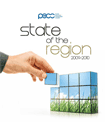State of the Region 2009 - 2010

The worst of the global economic downturn which began in late 2008 now appears to be behind us. Yet, the outlook for 2010 and for a sustained recovery in the Asia-Pacific region remains uncertain. While economic growth has returned to most major economies, the rebound has been weak, and there are serious concerns about the ability of governments to continue providing fiscal and monetary stimulus to their economies. The downside risks to growth are large and these risks will likely persist for the foreseeable future.
The most important of these risks is the problem of so-called “global imbalances”, which in practice boils down to an imbalance between on the one hand the United States – which is saving too little and carrying too much debt – and on the other hand the Asian economies – which have relied too much on US consumer spending and on holdings of US debt. The resolution of the “global imbalance” problem in effect requires the rebalancing of growth in the Asia-Pacific region.
Content:
Message from the Co-Chairs of PECC
Executive Summary
Chapter 1 - Crisis to Growth: Strategies for Recovery in the Asia-Pacific
- Chart 1-1: Real GDP Growth Projections (IMF, October 2009)
- Crisis, recovery and risks
- Chart 1-2: Fiscal and Monetary Measures
- Sustained growth beyond the crisis
- Chart 1-3: Rebalancing Demand
- Chart 1-4: Rebalancing Trade
- Structural policies
- Growth engines
- A role for Asia-Pacific institutions
- Layered Cooperation
Chapter 2 - Survey of Opinion-Leaders
- Rising Optimism on the Economic Outlook
- Chart 2-1: Expectations for growth of the global economy: in October 2008, May 2009 and October 2009
- Chart 2-2: What are your expectations for economic growth over the next 12 months compared to the last 12?
- Policy Responses to the Crisis
- Chart 2-3: How satisfied are you with the responses of the following economies to the crisis?
- Chart 2-4: How satisfied are you with the responses of the following international institutions to the crisis? (May 2009 compared to October 2009)
- Chart 2-5: Economies have largely avoided resorting to protectionist measures in response to the crisis
- Not yet time to exit
- Chart 2-6: It’s time to exit from expansionary fiscal and monetary policies in the United States, China, and Japan
- Chart 2-7: The US economy will recover from the economic crisis to retain its leading position in the world economy
- International Policy Objectives for Sustained Growth
- Table 2-1: Importance of the following policy objectives for achieving sustained growth in the Asia-Pacific over the next five years.
- What will drive growth over the next 5 years?
- Table 2-2: Growth Engines in the Asia-Pacific over the next 5 years
- Free Trade Agreements
- Regional and International Cooperation
- Chart 2-9: The G20 Leaders’ process should continue and be institutionalized even after the economic crisis is over
- Regional Architecture
- Chart 2-10: The Asia-Pacific needs a forum for Leaders to discuss political and security issues
- Chart 2-11: The East Asia Summit process will eventually overshadow APEC
- APEC Leaders Should Focus on the Economic Crisis
Chapter 3 - A Composite Index of Economic Integration in the Asia-Pacific
- Table 3-1: Comparison of 2005 and 2006 Composite Index
- Chart 3-1: Intra-regional trade share, Asia-Pacific
- Chart 3-2: Intra-regional FDI share, Asia-Pacific
- Chart 3-3: Intra-regional tourist inflow, Asia-Pacific
- Chart 3-4: Updated Convergence Index: 1991-2006
- Chart 3-5: Updated Composite Index: 1991-2006
How to Read the PECC Index of Asia-Pacific Economic
Technical Note on the Composite Index of Asia-Pacific Economic Integration
Annex - State of the Region Survey
Member Committees

